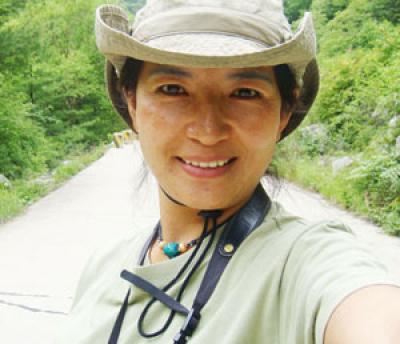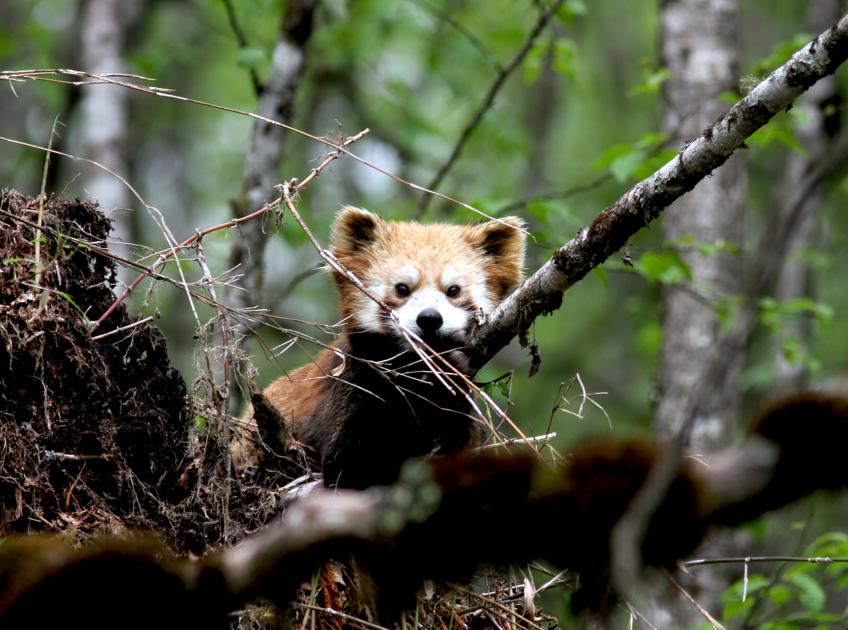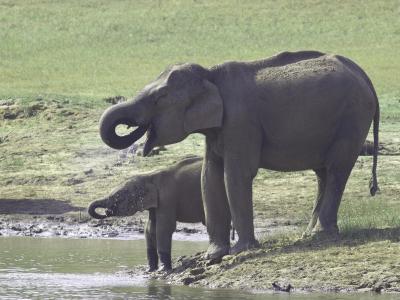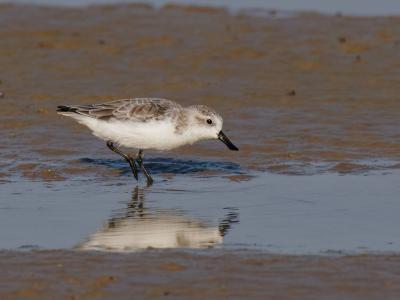China: Sichuan
-
May 24 to Jun 12 2026
Paul Holt and Wang Qingyu
-
May 23 to Jun 11 2027
Paul Holt and Wang Qingyu
Tour Price to be Determined
2027
Tour Price to be Determined
Tour Price to be Determined
2027
Tour Price to be Determined
Sichuan province, right in the heart of the Middle Kingdom, is a fabulously bird-rich region, home to the bulk of China’s endemic birds and most of its Giant Pandas. We’ll concentrate on seeing the endemic and near-endemic species as well as sampling the cuisine, genuine hospitality, and dramatic scenery for which this region is rightly famous. Although the wild mountainous terrain and torrential rivers have combined to keep the province isolated until relatively recently, today the impressive diversity of habitats and a well-developed tourist infrastructure make Sichuan a superbly appealing destination for a birding tour.
The great diversity of Sichuan’s habitats, ranging from the subtropical lowlands of the Red Basin and evergreen foothill forests to alpine meadows and dramatic snow-capped mountain peaks means the province has a remarkable wealth of birds. Lying at the eastern edge of the Tibetan Plateau, Sichuan also has the richest concentration of Chinese specialties and holds around two-thirds of the entire country’s endemic birds.
We’ll visit numerous sites, each one different and with its own charm and specific bird life: the plateau peak of Wawu Shan and Labahe, a valley that cuts into several of the mighty peaks that rise abruptly on the western fringe of the Red Basin; the town of Luding which we’ll use as a base from which to explore a different set of mountains; Siguniangshan and neighboring Wolong National Park, the latter famed as one of the homes for China’s few remaining Giant Pandas but also renowned as a haven for a large number of spectacular birds; the rolling grasslands at the extreme eastern edge of the Qinghai-Tibetan Plateau, where we’ll search for specialties such as Black-necked Crane, snowfinches and the bizarre Pink-tailed Finch, and finally heading easty over yet another might pass with its Blue Eared Pheasants and range-restricted Snowy-cheeked Laughingthrushes. Without a doubt Sichuan is the very best of China.
Day 1: The tour begins around 9 a.m. at Shuangliu International Airport in Chengdu, Sichuan’s attractive provincial capital city, and we’ll set off southwest across the Red Basin to Wawu Shan, where we’ll spend two nights in a comfortable hotel.
Wawu Shan (literally ‘Roof-tile Mountain’) is a plateau peak that dominates this part of southern Sichuan. It harbors a remarkable variety of species and, like its neighbor the sacred peak of Emei Shan, inaccessibility has been its savior and gorgeous forests and huge tracts of bamboo remain. Some superb birds occur here, and we’ll concentrate on finding several of the very localized endemics—primary among those are Sichuan Treecreeper (described from this site as recently as 1995), Emei Shan Liocichla, and Grey-hooded and Three-toed Parrotbills.
Shortly after arriving we’ll take a cable car from the foot of the mountain about two-thirds of the way up the mountain to our hotel. Despite the forests around the hotel ringing to the sounds of Chestnut Thrush, Large-billed Leaf Warbler, Himalayan, and Lesser and Large Hawk-Cuckoos, often making it a challenge to distinguish more subtle vocalists, we should still be able to find the likes of Emei Shan Liocichla, Red-winged and, with luck, Buffy Laughingthrushes, Wedge-tailed Green Pigeon, Golden Parrotbill and Martens’s Warbler. A comfortable hotel at Gongtong Shanzhuang will be our base for the following two nights.
Day 2: A second cable car links the area around our hotel at Gongtong Shanzhuang with the summit where vociferous Spotted Nutcrackers, and often showy Golden Bush Robins can be found. The summit is criss-crossed by a myriad of wooden boardwalk trails and we’ll spend a full day there exploring the ancient conifer forests, and dense tracts of rhododendron scrub and bamboo thickets. Holding healthy populations of Aberrant Bush Warblers, Buff-throated and Buff-barred Warblers and Grey-headed Bullfinches we’ll spend time exploring several different trails in this fascinating area. Numerous warblers, including eight bush warblers and no fewer than 17 species of phylloscopus, can be seen on this tour, and a good number of them breed here at Wawu Shan. Other possibilities include the magnificent White-throated Needletail, gorgeous Black-headed Sibia, Chinese Shortwing and Fulvous Parrotbill. Night on Wawu Shan.
Day 3: After another morning searching for specialties that we might have missed earlier, perhaps including Red-winged Laughingthrush and Hodgson’s Hawk Cuckoo (both much easier to hear than to see), we’ll drive west to Laba Gou, a similar forested sanctuary. Laba Gou shares many of the same species as Wawu Shan but some, such as the gorgeous Temminck’s Tragopan and Lady Amherst’s Pheasant, are easier to see.
Day 4: Spending a full day in Laba Gou, we’ll search out other species such as Brown and Spotted Bush Warblers. Here, as at Wawu Shan, we also have a reasonable (perhaps 50%) chance of encountering a Red Panda. Night at Laba Gou.
Day 5: After another morning at Laba Gou, we’ll drive further west to the town of Luding, where we’ll spend the next two nights.
Day 6: We’ll spend the day exploring the mountain of Erlang Shan on one of several roads that cross Sichuan’s high passes. Many of these roads have now been replaced by tunnels, which means that our birding should be relatively undisturbed by traffic. Lady Amherst’s Pheasants are common on Erlang Shan, and we expect to encounter several, hopefully including a resplendent adult male. Another target species here is one of Sichuan’s premier avian jewels, the fabulously named Firethroat. We should be able to find at least one of these truly world-class songsters. The supporting cast should include species such as Sharpe's Rosefinch, Slaty-backed Flycatcher, Chinese Babax, and Southern Nutcracker. Night again in Luding.
Day 7: After a final morning near Luding we’ll drive on to our next base near the city of Ya’an. Night near Ya’an.
Day 8: Leaving Ya’an, we’ll wind our way through deep valleys and narrow gorges, eventually reaching Rilong, a thriving tourist town at the foot of the mighty “Four Sisters Mountains,” where we’ll spend three nights but not before we’ve searched for more avian delights such as Speckled Woodpigeon, Sichuan Bush Warbler, and Slaty Bunting.
Days 9–10: Dominated by spectacular mountains, Rilong is an ideal base from which to explore the neighboring Wolong Nature Reserve. World-renowned as the headquarters of Giant Panda conservation, Wolong also has much to offer the birder. The whole area is scenically stunning, and although we’re unlikely to see a wild Giant Panda (though we have seen Red Panda in the reserve), the magnificently forested mountains, extensive stands of bamboo, splendid alpine meadows, and rugged snowcapped peaks harbor some truly outstanding birds.
With two full days to explore the area, we’ll have numerous options. We’ll cross the mighty Balangshan Pass on a daily basis, spending some time around the summit, which at just over 14,700 feet is the highest point we’ll reach on the entire tour. Small coveys of scurrying Snow Partridges and Tibetan Snowcocks are regularly seen on the scree slopes beside the road, as are Grandalas, the males dazzling in their cobalt-blue plumage. Other high-altitude specialties could include Bearded Vulture (Lammergeier), Red-billed and Alpine Choughs, Alpine Accentor, Brandt’s Mountain Finch, and Red-fronted Rosefinch. Koklass Pheasant, the recently-split Chinese Rubythroat and Kessler’s Thrush all breed close to the tree line here, and while the former is elusive and difficult to see, we’re sure to hear its unpleasant barking calls ringing across the valleys.
With luck we might also find a covey of handsome White Eared Pheasants or perhaps even a Chinese Monal. Farther down on the mountain’s mid-slopes we’ll search for both Barred and mighty Giant Laughingthrushes, as well as Chinese Leaf Warbler, Chinese Fulvetta, and Sichuan Thrush. Nor will we neglect the mammals—the park boasts reasonable populations of Himalayan Marmot and both Blue Sheep and Takin. Nights at Rilong.
Day 11: Leaving Rilong we’ll wind our way through another series of valleys and cross a few smaller passes on our way to Maerkang, where we’ll spend three nights.
Days 12-13: We’ll spend the days searching for birds on the Mengbi or Zhegushan Passes. Chestnut-throated Monal-Partridge, Chinese Grouse and Blood Pheasant are all fairly regular here, and other targets include Sichuan Jay, Eurasian Three-toed Woodpecker, Himalayan Bluetail, the strikingly patterned Przewalski’s Nuthatch, gorgeous White-browed and even more appealing Crested Tit Warblers, Chinese Fulvetta, Crimson-browed Finch, and Tibetan Serin. We’ll also have our first chance of seeing the poorly known Three-banded Rosefinch. Nights in Maerkang.
Day 14: After another morning on the Zhegushan Pass we’ll continue to the Qinghai-Tibetan Plateau proper. We’ll stop just as we crest the eastern edge of the plateau, where amid the more gently undulating grasslands we’ll explore a couple of isolated stands of conifers, searching in particular, if we haven't already seen it, for the endangered endemic Sichuan Jay as well as Sichuan and White-browed Tits and Plain and Elliot’s Laughingthrushes. Night in Hongyuan.
Day 15: Moving farther onto the plateau, past tented camps and fields of yaks, we’ll constantly scan for more specialties such as the comical Ground Tit, hulking Giant Grey Shrikes and Tibetan Larks, both White-rumped and Rufous-necked Snowfinches, and the spectacular Pink-tailed Finch, the latter now in a family of its own. Our destination is Ruoergai, a relatively modern Tibetan settlement right in the heart of some exciting plateau birding. In the afternoon we’ll head off to search the surrounding steppes for parties of majestic Black-necked Cranes, and with luck we might also find a Saker Falcon. Night in Ruoergai.
Day 16: We’ll spend a full day around this fascinating Tibetan settlement, exploring a variety of bird-rich habitats ranging from areas of conifer forest just off the plateau to other areas of scrub, rolling grassy meadows, and upland lakes. Here we’ll be looking for Blue Eared Pheasant, Tibetan Lark, White-rumped Snowfinch, Tibetan Fox and possibly even Wolf, among many others. Night again in Ruoergai.
Day 17: We’ll leave the plateau this morning and take a minor road over the spectacular La Ma Ling Pass to Jiuzhaigou. We’ll make numerous stops to search for species such as Chinese Long-tailed Rosefinch, Sichuan Jay, Daurian Jackdaw, Snowy-cheeked Laughingthrush, and Pink-rumped Rosefinch. Night close to Jiuzhaigou National Park.
Day 18: We’ll spend the morning near Jiuzhaigou National Park and will explore an area outside the park where both Snowy-cheeked and Barred Laughingthrushes are more regular and where we’ve also seen Three-toed Parrotbill, the diminutive Spectacled Parrotbill and Spectacled Fulvettas. In the afternoon we’ll start our journey back toward Chengdu, stopping at a couple of sites, perhaps for Siberian Rubythroat, Sichuan Tit, or White-browed Tit-warbler, en route. Night in Maoxian.
Day 19: Continuing south to Chengdu we’ll arrive in time to visit the Giant Panda breeding center on the edge of the city. Besides the pandas, birds here include Chinese Bamboo Partridge, Rufous-faced Warbler, Amur Paradise Flycatcher, Speckled Piculet, David’s Fulvetta, White-browed Laughingthrush, Vinous-throated Parrotbill, and Yellow-billed Grosbeak. Night in Chengdu.
Day 20: The tour concludes this morning in Chengdu.
Note: The information presented below has been extracted from our formal General Information for this tour. It covers topics we feel potential registrants may wish to consider before booking space. The complete General Information for this tour will be sent to all tour registrants and of course supplemental information, if needed, is available from the WINGS office.
ENTERING CHINA: United States citizens will need a passport valid for at least six months from date of departure and a tourist visa to enter China. Citizens of other countries may need a visa and should check their nearest Chinese embassy or http://www.china-embassy.org. If required by the embassy or visa-granting entity, WINGS can provide a letter for you to use regarding your participation in the tour.
COUNTRY INFORMATION: You can review the U.S. Department of State Country Specific Travel Information here: https://travel.state.gov/content/travel.html and the CIA World Factbook here: https://www.cia.gov/the-world-factbook/. Review foreign travel advice from the UK government here: https://www.gov.uk/foreign-travel-advice and travel advice and advisories from the Government of Canada here: https://travel.gc.ca/travelling/advisories.
CLIMATE: In Chengdu it will be hot and fairly humid. On the lower slopes of Wawu Shan and at Labahe it will be similarly hot and humid. Temperatures in these areas will typically reach up to 25-34°C (77-90°F) by midday. It will be cooler and less humid higher in the mountains where some of the early mornings can even be cold, perhaps dropping as low as -4°C (25°F) if the skies are clear. Rain is common in Sichuan throughout the year.
PACE OF TOUR AND DAILY ROUTINE: This is not an easy, relaxing tour. There is a reasonable amount of travelling and many of the days are long and tiring. Many of the trails that we will walk on are steep and while we’ll walk slowly we are still at altitude and it is easy to become tired. A reasonable degree of fitness is essential. Due to early morning bird activity we will want to be out in the field early each day. This will often mean leaving our hotel at 5:00am and having a picnic breakfast in the field.
HEALTH: The Centers for Disease Control and Prevention (CDC) recommends that all travelers be up to date on routine vaccinations. These include measles-mumps-rubella (MMR) vaccine, diphtheria-tetanus-pertussis vaccine, varicella (chickenpox) vaccine, polio vaccine, and your yearly flu shot. They further recommend that most travelers have protection against Hepatitis A and Typhoid. Advisories and recommendations by agencies such as the CDC frequently change. We urge you to consult your physician, local health department, or the CDC for the most up-to-date health advisories for travel to China. You can check with the CDC online here: https://wwwnc.cdc.gov/travel/destinations/list
Altitude: Our tour is operated at quite high altitude and we will spend considerable amounts of time above 3,500 meters or 11,000 feet and we’ll reach 4500 meters (14,764 feet). When at such high altitudes we will attempt to limit our activities, try to avoid excessively walking up hill and will move at a fairly slow pace so as to avoid altitudinal headaches. Most altitudinal problems can be overcome by sitting quietly in or near the vehicle and drinking plenty of fluids. There will be oxygen available in at least one of the vehicles that we will use on the bulk of the tour.
Insects: Biting insects are not numerous although mosquitoes are present in small numbers at a few sites.
Leeches: On some of the forest trails during the early part of the tour we may encounter a very few small terrestrial leeches.
Smoking: Smoking or vaping is prohibited in the vehicles or when the group is gathered for meals, checklists, etc. If you are sharing a room with a non-smoker, please do not smoke in the room. If you smoke in the field, do so well away and downwind from the group. If any location where the group is gathered has a stricter policy than the WINGS policy, that stricter policy will prevail.
Food Allergies / Requirements: We cannot guarantee that all food allergies can be accommodated at every destination. Participants with significant food allergies or special dietary requirements should bring appropriate foods with them for those times when their needs cannot be met. Announced meal times are always approximate depending on how the day unfolds. Participants who need to eat according to a fixed schedule should bring supplemental food. Please contact the WINGS office if you have any questions.
ACCOMMODATION: The hotels at Wawu Shan, Maerkang, Hongyuan, Ruoergai, Jiuzhaigou and in Chengdu at the end of the tour are of a good, international standard with en suite bathrooms, proper restaurants and other facilities that you would normally expect such as gift shops in the lobby and in room facilities for making international phone calls etc.
Elsewhere on the tour we will stay in a variety of adequate hotels and guesthouses, all with at least a private bathroom with western toilet, wash basin and shower. On occasion we may find that the showers and toilets don’t work properly and we may be restricted to washing with cold water or using hot water from the thermos flasks that are provided.
FOOD: The Chinese way of eating differs from that in the west in that those sitting at the table share selections of different dishes. Food is almost always plentiful. Few of the restaurants we’ll visit provide knives and forks. Instead chopsticks, often disposable wooden ones, are used.
In contrast to evening meals typical Chinese breakfasts are disappointingly poor and unappealing to most westerners. They consist mostly of cold dishes – soy milk, steamed dumplings and rice porridge. Consequently, away from the international style hotels in Chengdu where a variety of more western style dishes are available, we will have very few hotel breakfasts opting instead to have picnic breakfasts. These will usually consist of items such as muesli, instant noodles, biscuits, chocolate, fruit, peanuts, bread and jam (where bread is available). On quite a few days we will also have picnic lunches and these will consist of similar items and probably cheese and/or ham or jam sandwiches.
INTERNET AND WIFI: As you would expect an ever increasing number of hotels that we use have internet access, and recently, everywhere we stayed had Wi-Fi in the rooms. Participants should be aware, however, that internet access is occasionally suspended in China – perhaps because of floods, landslides or political issues. Mobile phone coverage is superb over most of China and, while not all foreign mobile operators have agreements with the Chinese carriers, many do. You are advised to contact your mobile phone provider in advance of the trip to confirm this.
TRANSPORTATION: Transportation throughout is by minibus. Tour operator’s vehicles are not allowed down to Huar Hu (= Flower Lake) near Ruoergai so instead we will have to use a shared park minibus.
2025 Narrative
Four species were essentially ‘in the running’ for honours in the end of trip ‘Bird of the Tour’ poll – but unusually this year only one of them was a galliform. The brilliant performance from a pair of spectacular Pink-tailed Finches, a bizarre taxonomic conundrum now honoured with a family of its own, ensured that it romped home as winner of that poll. We saw them just once - on our first full day up on the Qinghai-Tibetan Plateau and a full two weeks into the tour. Our encounter involved a pair and we revelled in the male’s spectacular aerial parachuting song flights and his hurried, bizarrely intense song as they came closer, and closer and closer... Second place, thanks largely to the group’s two more avid photographers, went to the ever gorgeous, cobalt blue Grandalas that we saw at almost 4500 metres close to the summit of the Balangshan Pass. Third place was shared by Giant Grey Shrike and Chestnut-throated Monal-partridge. We had several encounters with the shrike, a scarce and often difficult species find, including one where we watched a parent feeding two young in a roadside bush. We had no less than four encounters with those often noisy, often in-our-faces, partridges… The ever-resplendent Firethroat was fifth, the majestic Tibetan Snowcock sixth and despite a fantastic, close-range encounter with a male White-browed Tit-warbler that species still only managed seventh, tying with Chinese Monal and Common Pheasant…
Impressive though the bird list was it wasn’t all plain sailing, however. Less than 24 hours before the tour started we received information that our first site, and one that we would spend two nights and parts of three days at, was firmly closed! Fortunately, our experienced and highly resourceful ground agent scrambled and hey presto, the very next day we headed off to Wawu Shan instead. Things started well on the first full day of our mammoth 20-day tour with two Mountain Hawk Eagles over the Caoba services before we’d even reached Wawu Shan. Once there our first few hours on the mountain introduced us to some of the site’s more common species – Asian House Martins nesting in the cable car station, Yellowish-bellied and Aberrant Bush Warblers seemingly in every patch of bamboo with Buff-barred, Martens’s and Large-billed Leaf Warblers singing at us from every conceivable perch…It was early the following morning however before things really kicked off with a close-range Himalayan Owl even before the sun came up. Four vociferous species of cuckoo were also immediately outside our comfortable hotel as were a pair of Emei Shan Liocichlas, several cooperative Red-winged Laughingthrushes and our first parrotbill in the shape of a spectacular Golden. Taking a cable car up to the summit and its fantastic old growth conifer forests, huge expanses of bamboo and myriad phylloscopus warblers we were treated to great looks at some more of the mountain’s specialities – starting with a close range Spotted Bush Warbler, then two Black-headed Sibias, and several, ever elusive, Chinese Shortwings. A couple of enchanting Golden-breasted Fulvettas, two Sichuan Treecreepers that we worked tremendously hard for, and two more parrotbills – Fulvous and the range restricted Three-toed soon followed.
Although spectacular Wawu Shan, with its cloud forest and seas of bamboo, its comfortable hotel and its speciality birds, was the first of the seven very different sites that we visited on this comprehensive tour things really came alive at Labahe, the second. It was there that we really saw our first gamebirds – our first Lady Amherst’s Pheasant (we’d finish the tour having seen seven and heard a remarkable 29 others) and a resplendent male Temminck’s Tragopan; it was at Labahe where we encountered our first fast-moving mixed species feeding flocks, our first Speckled Wood Pigeons, Fire-capped Tit, a very confiding Brown Bush Warbler and a similarly obliging White-bellied Redstart. Oh, and then there was the remarkably arboreal Chestnut-headed Tesia. It was also at Labahe where we’d see both of our magnificent Red Pandas…the first, a superbly inquisitive individual, watched us for the best part of 15 minutes before gradually slinking off back in to the rhododendron forest, while the second was almost close enough to pet (not that any of us would have dared)…We’d move on from Labahe, via a service station with some fabulously acrobatic, effortlessly cruising White-throated Needletails, to Luding, or more correctly the neighbouring Erlang Shan pass. There we birded along a largely disused road now circumvented by a road tunnel that takes virtually all the traffic. It was there where Sharpe’s and Vinaceous Rosefinches, our first Slaty-backed Flycatchers and Green Shrike Babbler, a confiding Brown and several Ashy-throated Parrotbills, umpteen Black-streaked Scimitar Babblers, our first Giant and some very inquisitive, and vociferous, Barred Laughingthrushes as well as hundreds of phylloscopus warblers and our only Crested Honey-buzzards performed. A couple of small flocks of Chinese Babax also entertained. The exquisite and superbly named Firethroat is always among our primary targets on the Erlangshan – and this year didn’t disappoint as we actually saw five birds and heard four more. We also connected with two of its congeners - White-tailed and Indian Blue Robins.
Moving on from the Luding area we spent the following night in a new hotel in Baoxing before visiting Pere David’s house and some of his haunts near Dengchigou the following morning. There we heard our first Sichuan Bush Warblers, a species formally described as recently as May 2016, singing even before we’d clambered out of our tour coach and would go on to also find another Bay Woodpecker, three species of minivet and our only Grey-winged Blackbird, Snowy-browed Flycatchers and Brown Bullfinches of the entire tour. A lucky few would catch a glimpse of another Temminck’s Tragopan! Later, as we ascended the mighty Jiajinshan Pass, we’d see some roadside Himalayan Vultures moments before the cloud closed in…
The world-renowned Wolong Giant Panda Reserve was our next port of call. It’s always exciting to be here – even when the weather, with drizzle and low cloud, was as frustrating as it was on our first day this year. For both of the following two days, as we shuttled from our guest house in Rilong, past the mighty Four Sisters Mountains (Siguniangshan), and into the park, we’d cross and re-cross the mighty Balangshan Pass; one day using the new road tunnel, on the other venturing up the old road almost as far as the summit of the pass itself. Even in June the weather atop this 4500-metre pass can be truly awful but we were fortunate and, although it was certainly cold (a chilly minus 4⁰C early morning), long-range visibility could hardly have been better and our perseverance paid off. We saw virtually all the birds that we had hoped for gradually whittling away at our target species - our first White Eared Pheasants, Snow Pigeons, Golden Eagle, Bearded Vulture (Lammergeiers to most of us) and Sichuan Tit. Other high-altitude species we saw closer to the pass included both Red-billed and Alpine Choughs, our first White-throated Dippers, five Chinese Rubythroats, both Plain and Brandt’s Mountain Finches and good numbers of Crimson-browed Finches. Many of us will undoubtedly long remember the immaculate cobalt-blue male Grandalas high on the pass, the Red-fronted Rosefinches (reputedly the world’s highest breeding passerine although the recently rediscovered Sillem’s Mountain Finch could perhaps also now claim this title), the long-time cooperative Tibetan Snowcocks (five seen and another three heard) and the Snow Partridges (two seen and two others heard). We had two magnificent full days in Wolong National Nature Reserve and, if we thought that the forest scenery at Wawu Shan and Labahe had been impressive, it sure was at Wolong. Gorgeous, old-growth forests filled the valleys while spectacularly jagged mountain peaks and rolling, flower-filled meadows dominated the higher elevations.
After Wolong we made rapid progress to our next base, Maerkang. Needless to say, we found even more goodies as we drove towards the summit of the Mengbi Shan, another high altitude pass on route. One of our primary targets, Chinese Long-tailed Rosefinch, didn’t really cooperate (but would do so a later stage, elsewhere on the tour) and it was close to the summit of that pass that we also saw our first Chestnut-throated Monal-partridges, our first Blood Pheasants and our first Sichuan Jays…
We spent the following three nights in the attractive, and obviously ethnically Tibetan, Maerkang town. Gorgeous weather during our fruitful day excursions helped us see no less than six more Blood and 11 more White Eared Pheasants but it was the two majestic male Chinese Monals that had us transfixed (they’re an absolutely stunning, multicoloured, glistening gamebird). It was also here, near Maerkang, that we saw our first Przevalski’s Nuthatches, our first Long-tailed Thrushes and our first Crested Tit-warblers, a truly spectacular creature, and had stunning looks at several enigmatic Three-banded, one of eleven species of rosefinch we’d see. Several satisfying encounters with Sichuan Tit and Sichuan Jay rounded things off nicely.
We’d have great looks at more Blood Pheasants, Chestnut-throated Monal-partridges, Firethroat and Chinese Fulvettas the following morning. Add to this a Chestnut-crowned Bush Warbler that came from a remarkably long way away to check us out. And then it was time to head up on to the Qinghai-Tibetan Plateau proper. There it wasn’t just the avifauna that changed - we’d see both Tibetan and Red Fox, Black-necked Cranes galore but only two Saker Falcons and three Tibetan Partridges. Black-backed Citrine Wagtails put on fine displays as did several gargantuan Tibetan Larks. A scrub covered valley on route to Ruoergai yielded the rasping Tibetan Partridges and an equally exquisite male White-browed Tit Warbler but it was the aforementioned confiding pair of Pink-tailed Finches that really stole the show…
We had a full day on the Plateau near Ruoergai and chose to spend it at Hua Hu (literally ‘Flower Lake’). An early start ensured that we made it on to the morning’s first park shuttle bus and avoided the crowds, at least for a while. Unfortunately, however the early morning rain didn’t really ease up – but changed to sleet and then snow before switching back. Nevertheless, the lake’s myriad Red-crested Pochards, Brown-headed Gull, snowfinches and larks competed for our attention with local rarities species such as Brown-cheeked Rail and both Whiskered and White-winged Terns. Wet and cold, we had a picnic lunch on site before slowly returning to town for a well-earned early break.
We headed away from Ruoergai the following morning, dropped abruptly off the Plateau and back into conifer forest. We’d not been at the appointed site for long, but long enough to admire our best performing Hog Badger of the tour, when we heard our first Snowy-cheeked Laughingthrush, then a Siberian Rubythroat and later a braying Blue Eared Pheasants. It took us a while, but we eventually found the three of them. We had a lengthy drive that day – heading west, up and over our final high pass, the Lamalingshan. Although there weren’t many new birds today - more Blood and Blue Eared Pheasants, Plain Laughingthrushes, our only funebris Eurasian Three-toed Woodpecker (split by some), great looks at multiple Tibetan Serins and both White-throated and Brown Dippers, on the same stretch of river, that day was the best on the entire tour for the number of species logged - a modest 90!
Although we’d driven past a few the day before, our first Chinese Leaf Warbler had to wait until the penultimate day when we were near Jiuzhaigou National Park. We’d see umpteen of them that day, chanting from their conifer top, exposed perches. Grey Nightjar, Spectacled Fulvetta and Pere David’s Tit were the only other additions to our bird list that morning, but umpteen other species would provide us with their best looks yet. Those included the delights of Speckled Wood Pigeon, Barred Laughingthrush, Green Shrike Babbler, Chinese Thrush and Slaty Bunting. The drive south from Jiuzhaigou was fairly uneventful, one forced detour made it no shorter than expected, but thankfully no longer either and it was an attractive drive, through some of the tour’s most spectacular mountain scenery, to Maoxian. We made rather few stops on route but those did include one to admire a close Chinese Goral, spent the night in Maoxian and had another drive of just under four hours the following morning. The latter took us through Wenchuan, epicentre of the tragic May 2008 earthquake that claimed the lives of an horrific 85,000 people, back to Chengdu.
The tour started, and finished, in Chengdu which, with a population fast approaching 21 million, is already China’s fourth largest city. However up until the very last day we’d done little birding there. Our tour route had taken us scurrying from there south to Wawu Shan. We then explored Labahe before continuing our loop north to Luding and the Erlang Shan, then Baoxing, Rilong and Wolong National Park followed by Maerkang, Hongyuan, Ruoergai and finally Maoxian. With hardly a moment to spare we’d birded amongst some of the best scenery on the planet and had revelled in great looks at a good many of the region’s avian specialties.
Great infrastructure, superb hospitality, a first-class ground agent, some outstanding food and a fabulous group rounded off what had been a fantastic tour! Historically remote and difficult to access, Sichuan is still blessed with rich and varied ecosystems ranging from subtropical lowlands at sites such as near Baoxing, through cool temperate forests to alpine grasslands on the edge of the Qinghai-Tibetan Plateau. Equally importantly, Sichuan is the heart of China’s astonishingly rich ‘endemic zone’ and harbours about two-thirds of China’s endemic birds.
Although the weather could have been better, Qingyu’s flawless logistics and a keen, ever-enthusiastic group meant that we’d reaped the rewards. Gamebirds feature highly on any Sichuan tour and this year we encountered 14 species of galliform with 11 of those being SEEN by ALL of the group! These included Snow Partridge; some great looks at Tibetan Snowcock; some obliging Tibetan Partridges, several Chestnut-throated Monal-Partridges; umpteen Blood Pheasants; some superbly cooperative, remarkably confiding Chinese Monals; umpteen White Eared and several close range Blue Eared Pheasants. Unfortunately, we never managed to see a Golden Pheasant or, more surprisingly, a Koklass Pheasant – but we tried and tried and tried and had to be satisfied with what was already an impressive haul. But that wasn’t the end of it as other goodies among the 300+ species that we encountered included a total of 172 Black-necked Cranes (with up to 117 on each of the three days we were on the Qinghai-Tibetan Plateau); some cracking looks at a couple of Saker Falcons; five Giant Grey Shrikes; superb looks at several family parties of Sichuan Jays; Przevalski’s Nuthatches on four days, no less than seven Snowy-cheeked Laughingthrushes, 16 species of phylloscopus warbler and at least eight Siberian Rubythroats. We’d also seen ten species of laughingthrushes with some such as Snowy-cheeked, Barred, Giant and Red-winged being poorly known and rarely encountered; seven species of parrotbill including the poorly known Three-toed and 11 species of rosefinch including possibly as many as 30 Red-fronted, several Chinese Long-tailed, and up to three Three-banded.
We’d experienced so much more than some exciting birds however and had revelled in some truly memorable scenic drives though spectacular gorges and over impressive passes. Many of us will long remember the hillsides full of fluttering prayer flags, the thousands upon thousands of feral yaks and the tremendous hospitality we'd been shown throughout. As always, the list of highlights goes on and on…It had undoubtedly been tiring and hard work but fabulous, fabulous fun and we’d had a great time!
- Paul Holt
Paul has an uncanny ability to identify and locate the distance of birds by his hearing sounds unheard by others, and the knowledge of the right persistence to draw the birds in for view. He also uses his positive personality to engage and draw in the best of the locals and bystanders.
- Gil E. on China: Sichuan
Qingyu could not have done a better job managing all the logistics, translations, the accommodations, and the meals. Excellent! And she was a good spotter too.
- Gil E. on China: Sichuan
We can assist with booking extra nights at our Chengdu hotel and airport transfers upon request.
Maximum group size 10 with two leaders. Both leaders will accompany the tour irrespective of group size.











































